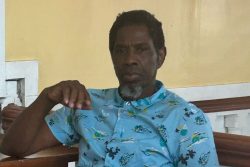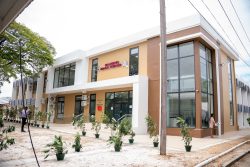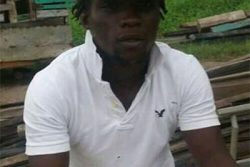The 1763 Berbice uprising is commemorated by the 1763 monument more popularly known as the ‘Cuffy monument,’ although the sculptor never approved of that moniker. It was unveiled on May 23, 1976, to mark Guyana’s tenth independence anniversary.
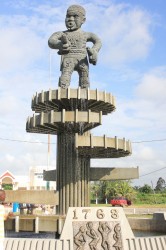
Well-known Guyanese sculptor Philip Moore, who died last year, designed the monument. He told Stabroek News in an interview before he died that he had answered an advertisement in the newspaper for the submission of a maquete for a monument to the 1763 rising, and that he was happy when his submission was accepted.
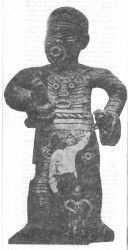
The bronze statue and its plaques were cast in England by the Morris Singer Foundry of Basingstoke, between August 1975 and February 1976, and the model-maker was David Gillespie of Farnham, Dorset in England.
The late Donald Locke, who was in England at the time the statue was at the foundry, used to tell a story that he was contacted by the Department of Culture while he was in England and asked to speak to the foundry about the progress of the monument. He said he was asked by the foundry where the monument would be sited, because if the environment was restricted and viewers had to stand close to the statue looking up at it, owing to perspective, the head would have to be cast slightly larger than the one on the maquete if head-body proportions were not to appear distorted.
The initial discussions about a possible site did relate to an area with limited space, and Locke’s understanding was that the head was indeed cast slightly larger in relation to the body than the one seen on the maquete. By the time the statue returned, however, it had been decided to locate it at Square of the Revolution, where there is ample space, and where it is normally viewed from a distance.
The plinth for the statue was designed by Albert Rodrigues. The contractors for the plinth were S A Nabi and Sons, while the structural engineer was Dr David Klautky.
According to the official leaflet of the monument distributed by the Castellani House the pouting of the mouth on the figure is a sign of defiance and resistance. The face on the chest is symbolic of the shield used as a breastplate, and is meant as protection in battle.
It goes on to say that the body is corrugated and marked with lines from the crown of the head to the toes. In the hands are a pig and a dog being throttled; the pig with a fish-like tail represents ignorance, and the dog covetousness, lust and greed. This image, the leaflet says, is inspired by a quotation from the Holy Scripture: “Cast not your pearls before swine nor give what is sacred to the dog.”
“The faces on the thighs with horns,” the leaflet continues, “represent the revolutionaries of Guyanese history, like Quamina and Accara and the fact that Cuffy considered past leaders in solidarity with his revolt. The horns are the attack and defence apparatus of the ox and other animals.” Moore identified Cuffy as a country man, with feet rooted in the soil. He wears a belt made of rope and a knife in a pouch on his right hip. The faces at the back of the head and body are intended to represent present-day leaders and the map of Guyana represents unity among all.
The five plaques around the plinth are ‘Seeking Inspiration,’ ‘Uniting People,’ ‘Destroying the Enemies,’ ‘Control’ and ‘Praise and Thanksgiving.’
The first plaque shows Cuffy and his friends communing with the spirits of their forefathers in the dead of the night, to see how best they could overthrow their enemies. Six hearts with the symbol of the clenched fist on each are shown on the second plaque. It depicts the manner in which the slaves lived, the differences in the living quarters of house slaves and field slaves although the differences do not mean division, since the slaves are united spiritually.
The third plaque carries two clenched fists with two long nails protruding from each and going into two large, disfigured hearts which represent the greed and avarice of the sugar plantation owners. The fourth shows two figures holding onto a wheel made to look like the joints of a cane with a central hub representing Cuffy which means that he took control. And the firth plaque carries four figures dancing and giving thanks to God for their deliverance.
In a review of the monument the late Denis Williams described it as a secular work which embodies “all characteristics of the scared sculpture of West Africa; immateriality and spiritually, a disregard of the natural proportions of the human figure (in West Africa this is usually 1:4 in head to torso) and, above all, frontality and an emphasis on the face.”
He wrote that this is one of the grounds that the Guyanese spectator will likely find the work strange and unfamiliar because its structural principles are different from those of European sculpture. According to Williams the axial principle is ignored in Moore’s monument in which the spectator’s interest is guided round the work of his articulation of the surface, not the forms of his figure.”
Williams described it as “ancestral” in the African sense. “The spirit of intelligence, defiance and resolution which is recorded in the written documents is what guided Moore’s conception as a whole, the stance of the figure being perhaps its most remarkable and original element. The history of art has rarely given us a posture in public sculpture that is more eloquent of an ideal,” Williams wrote.






